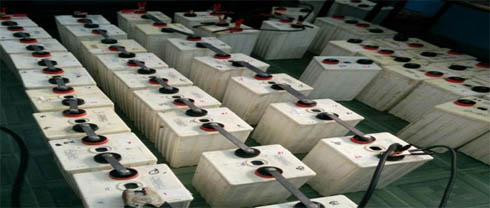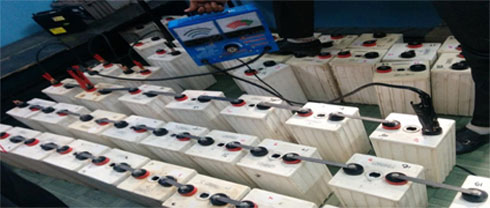Rejuvenation Services >> 2V/12V Lead Acid Battery
Rejuvenation Process of 2V/12V Batteries
1. Screening: -
a) Physical Condition : - Check Leakage, Terminal or Case Breakage and Terminal conditions for corrosion . Open the vent of Batteries to see the plate condition from inside.
b) Digital Battery Analyzer (DBA) Reading : - Connect six cells in series and take readings of each set. The parameters to be measure are OCV (Open Circuit Voltage); Internal Resistance (OHM); Cold Cranking Amperes (CCA)
c) Hydrate (add DM Water) all the cell s and Leave for at least 1 Hour.
d) Measure the Specific Gravity (SG) of each cell.

a) Connect all the cells in series with the help of lead strips. ( Tightly)
b) Connect the battery set with Hybrid .
c) Set the Hybrid on Custom Constant Charge mode.
d) Boost current has to be above 10% of AH value for 1Hr.
e) Rest the battery for 1Hr to Cool Down.
3. Screening After Boost Charge: -
a) Take the DBA Readings of every battery set of 6 cells each .
b) Take open circuit voltage of every cell.
c) Take Gravity reading of all 2V cells .
d) Take Load Circuit Voltage (LCV) o f every cell by putting load current equal to the AH value of each cell. For example, if a 2V cell is of 400AH then the Load current to be set in the carbon pile tester has to be around 400A or the maximum current a battery delivers.
e) After putting the load ; LCV of each of 6 cells is t o be measured in not more than 2 0 sec. Then the load has to be reduced to zero immediately. Batteries having LCV less than 1. 6 V /cell should be rejected from the battery bank series.
 4.
Charging
:
-
4.
Charging
:
-
a) Connect all the cells having LCV above 1.6V in series to max of 90 Cells of 2V or 14 batteries of 12V each .
b) Add Power plus additive to each cell equal to AH value/100 X 30Ml. Example for 400AH the additive has to be 400/100X30Ml = 120ML.
c) Set Hybrid on Resonance Charge Mode .
d) Set current at 5% of current at the rated AH Value. For Example, if cell is of 400AH then we have to set current at 20A.
e) In order to set the time on Hybrid we have to add 20 - 25% of AH to the original AH of the cell and then divide i t by 5% of the charging current to get the charging time . For example, for 400AH cells a d d 25% extra AH, this becomes 400+25% of 400= 400+100=500AH. Now divide 500AH by 20A. This gives us 25Hour, so the process has to be initiated with 20A charging current for 25Hrs.
f) Then keep on measuring each cell voltage and SG in every 2 Hrs . If any cell does not show improvement even after half of the process time, then that cell is to be removed.
g) After completion of the process leave the batt eries for cooling for at l east 4 Hrs .
5. Process After Charging: -
a) Take the DBA readings of every set of 6 cells in series; as taken before during screening.
b) Measure OCV of Every Cell.
c) Measure SG with Hydrometer of Every Cell.
d) LCV of each cell has to be measured at around 100% of AH value current (process time not more than 30sec for 6 cells) with the help of carbon pile tester on every set of six cells .
e) Reject all cells below 1.8V LCV . All remaining cells are good to go for discharge test.
6. Discharging: -
a) Connect the best 24 cells in series and make a battery bank of 48V .
b) Connect a discharger to the battery bank and connect a clamp meter to the positive cable coming from the battery to discharger. Set the Discharger at C10 rating current.
c) Take the voltage r eadings of every cell with the help of Multimeter in every 15 minutes.
d) Take out the cells which drop below to 1. 75 V. Note the time at which the cell comes out of the Bank, this gives the backup attained by individual cell in Minutes. Repeat this till maximum cells attain the ECV of 1.8 - 1.9V Or the bank voltage reaches 43.5V. Leave the batteries to cool for 2 Hrs.
7. Final Charging: -
a) Connect all the selected cells in series and put them on 10% charging current for 10 Hrs . Do the CD cycle 3 - 4 times on serviceable load for best results.
Click here for Download - Battery Selection Guide Chart